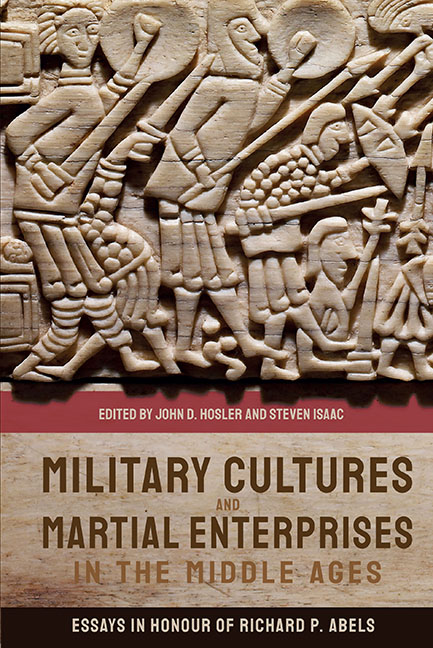Book contents
- Frontmatter
- Contents
- List of Illustrations
- Notes on Contributors
- Introduction and Appreciation
- 1 Charlemagne’s Invasion of Spain in 778: The Anatomy of a Strategic Failure and its Impact
- 2 Military Intelligence and Strategic Planning Under the Ottonian Kings of Germany, 919–1024
- 3 Ain’t Nobody Here But Us Chickens: Defeated Warriors, Masculinity, and Mistaken Identity in Western Europe, 679–1141
- 4 Count Baldwin V of Flanders: Broker of Eleventh-Century Power
- 5 Kings and Fortuna: The Meanings of Brémule
- 6 Fighting the Last War: Remembering the Norman Conquest during the Anarchy
- 7 Gilbert of Mons’ Chronicle of Hainaut as a Source for Military History in the Twelfth Century
- 8 At Home with Roger of Howden
- 9 Embedded Reporters? Ambroise, Richard de Templo, and Roger of Howden on the Third Crusade
- 10 The Treatment of Male and Female Prisoners of War during the Third Crusade
- 11 Exempla, Crusade, and Chivalry
- 12 Frontier Warfare in the St Omer Chronicle
- 13 Some Observations on the Training of Medieval Warhorses
- Richard P. Abels’ Curriculum Vitae
- Index
- Tabula Gratulatoria
13 - Some Observations on the Training of Medieval Warhorses
Published online by Cambridge University Press: 21 October 2020
- Frontmatter
- Contents
- List of Illustrations
- Notes on Contributors
- Introduction and Appreciation
- 1 Charlemagne’s Invasion of Spain in 778: The Anatomy of a Strategic Failure and its Impact
- 2 Military Intelligence and Strategic Planning Under the Ottonian Kings of Germany, 919–1024
- 3 Ain’t Nobody Here But Us Chickens: Defeated Warriors, Masculinity, and Mistaken Identity in Western Europe, 679–1141
- 4 Count Baldwin V of Flanders: Broker of Eleventh-Century Power
- 5 Kings and Fortuna: The Meanings of Brémule
- 6 Fighting the Last War: Remembering the Norman Conquest during the Anarchy
- 7 Gilbert of Mons’ Chronicle of Hainaut as a Source for Military History in the Twelfth Century
- 8 At Home with Roger of Howden
- 9 Embedded Reporters? Ambroise, Richard de Templo, and Roger of Howden on the Third Crusade
- 10 The Treatment of Male and Female Prisoners of War during the Third Crusade
- 11 Exempla, Crusade, and Chivalry
- 12 Frontier Warfare in the St Omer Chronicle
- 13 Some Observations on the Training of Medieval Warhorses
- Richard P. Abels’ Curriculum Vitae
- Index
- Tabula Gratulatoria
Summary
A GERMAN PROVERB PARAPHRASING an old Carolingian maxim observed, “He who has stayed at school till the age of twelve, and never ridden a horse, is fit only to be a priest.” The aphorism obliquely refers to the chief practitioners of the medieval horse culture, the secular nobility, who received rigorous instruction in horsemanship from an early age. One particularly demanding aspect of this lifelong education entailed the schooling of horse and rider in the performance of turns. These moves, in contrast to the one directional charge of set battles and jousts, demonstrate the maneuverability to perform feigned retreats as well as skirmishing and ravaging warfare, now considered the most prevalent form of medieval mounted combat. The topic requires laying extensive groundwork to make certain principles of horsemanship and horse training intelligible to the uninitiated reader, a process that involves enhancing the meaning of texts discussed previously.
Emergence of the Western European Equestrian Tradition
At either end of the chronological spectrum two treatises, Arrian's Ars Tactica of c. 136–37 CE and Federico Grisone's Ordini di Caualcare of 1550, explained equestrian maneuvers. For the intervening period in the Latin West, information on horse training is scattered in various sources. Medieval horse trainers were men of action who transmitted their knowledge through oral tradition. The best practitioners were not always the best explicators. The Histoire de Guillaume le Maréchal, has little to say about the subject. His career illustrates the tremendous upward social mobility that could be achieved in this medieval horse culture. William Marshal managed to parlay his skills as tournament champion into major governmental service, eventually becoming Regent of England. King Duarte of Portugal, the author of a treatise on horsemanship, had intended to write a complementary work on the training of war horses; unfortunately, the plague prematurely ended his life. Grisone, who acquired a reputation for brutal training methods, still set down in writing principles that represent the culmination of the medieval oral tradition, and the widespread acceptance of the work ensured its preeminence as the foundation of the European equestrian heritage.
- Type
- Chapter
- Information
- Military Cultures and Martial Enterprises in the Middle AgesEssays in Honour of Richard P. Abels, pp. 237 - 256Publisher: Boydell & BrewerPrint publication year: 2020

